Stony Brook, NY, July 17 - November 2, 2023 - #LISoundFacts is a collection of facts about the health of Long Island Sound (LIS) and its diverse habitat and wildlife.
The three month-long social media campaign represents a partnership between New York Sea Grant (NYSG) and the Long Island Sound Study (LISS), with illustrations by graphic artist Lucy Reading.
You can engage with our #LISoundFacts posts (like, comment, share) on Facebook, Twitter, and on Instagram (see embedded posts below) — the first two of which where posts run July through September and the last of which where animated posts run September through November.
LIS is one of the 28 nationally designated estuaries under the National Estuary Program (NEP), which was established by Congress in 1987 to improve the quality of these unique aquatic places where rivers meet the sea.
Led by the U.S. Environmental Protection Agency and the states of New York and Connecticut, LISS is a cooperative effort involving researchers, regulators, user groups and other concerned organizations and individuals
Created in 1971, NYSG is a cooperative program of Cornell University and the State University of New York. NYSG is one of 34 university-based programs under the National Sea Grant College Program that works with coastal communities through the National Oceanic and Atmospheric Administration.
Navigate to ... Week 1 | Week 2 | Week 3 | Week 4 | Week 5 | Week 6 | Week 7 | Week 8 (bonus) | Week 8 | Week 9 | Week 10 | Week 11 | Week 12
Week 1: Marine Life and Marine Debris Don't Mix | back to top
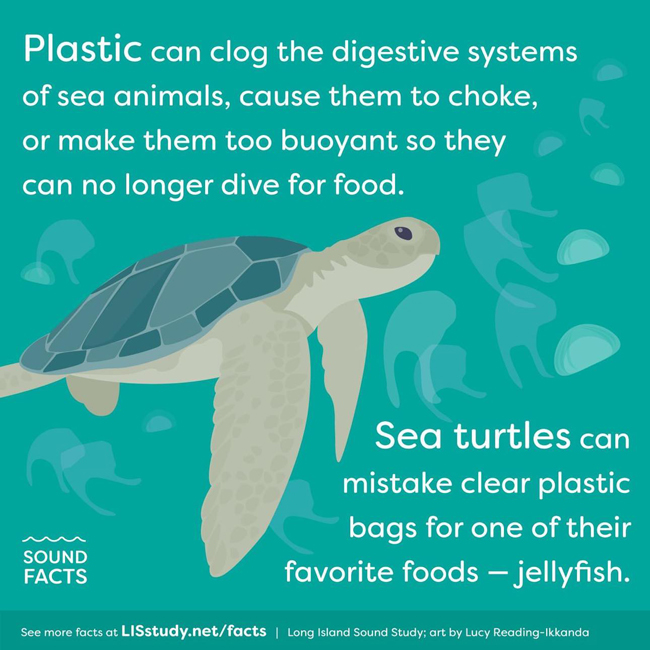
The Long Island Sound provides habitat for five of the seven species of sea turtles that swim our oceans.
#LISoundFacts: One simple way to help sea turtles is to keep plastic pollution away from our waterways: bit.ly/lisoundfactsseaturtles.
More "Marine Debris / Plastic Pollution in New York's Waters" resources from New York Sea Grant at www.nyseagrant.org/marinedebris.
View this post on ...
Instagram
If the embed for the Instagram post above doesn't show, click here to see the post on Instagram.
Twitter
Facebook
Week 2: Horseshoe Crab Monitoring | back to top
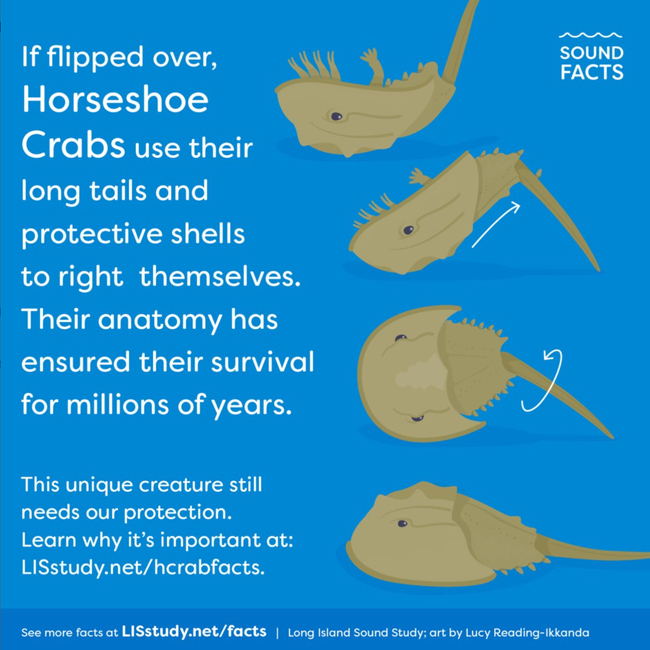
From about mid-May through June in Connecticut and New York, horseshoe crabs usually come ashore to spawn around #LongIslandSound.
Resource managers around the Sound monitor horseshoe crabs through beach counts and tagging to better understand their patterns of movement and track their abundance.
#LISoundFacts: You can help in the monitoring efforts by reporting a tag to the appropriate agency or by becoming a citizen scientist.
More Sound Facts about this important species in the Sound …
• Horseshoe crabs have existed for more than 450 million years - before dinosaurs were around.
• Despite their name, these animals are not actually crustaceans like real crabs are (such as the fiddler crab or the blue crab); instead, they are more closely related to arachnids such as spiders and scorpions.
• Interestingly, horseshoe crabs play a very important role in human health. The blood of a horseshoe crab is blue due to a copper-based protein called hemocyanin, which transports oxygen much like our hemogoblin does. But their blood also contains a product called Limulus Amebocyte Lysate (LAL) that is harvested and used to identify the presence of harmful bacterial toxins in vaccines and other medical devices. Since no synthetic equivalent has been federally approved for use to date, LAL continues to be an indispensable tool in modern medicine.
To learn more, visit bit.ly/lisoundfactshorseshoecrabs.
View this post on ...
Instagram
If the embed for the Instagram post above doesn't show, click here to see the post on Instagram.
Twitter
Facebook
Week 3: Atlantic Coast Piping Plover | back to top
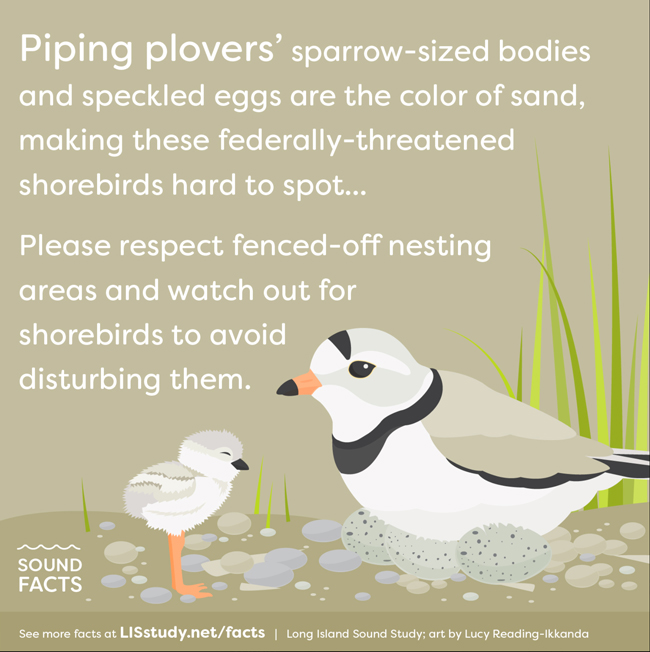
The Atlantic Coast Piping Plover (Charadrius melodus) spends the winter in the Southeast US and Caribbean, and migrates north during the warmer months.
#LISoundFacts: Please take extra caution to avoid disturbing this little shorebird that nests on #LongIslandSound beaches beginning each year in the spring.
Piping Plovers can be found nesting along the coast of the Sound in flat, open areas of the beach, where they lay their eggs directly on the sand.
To protect them, local environmental organizations and agencies usually place signs and fence-off areas where the shorebirds may be nesting.
Please take extra caution to avoid disturbing nesting Piping Plovers and their habitats.
Here's what you can do:
• You can help by social distancing from birds.
• When on the beach, walk on wet sand in case any Piping Plovers have nested outside of posted and/or fenced-off areas.
Find out more in "Piping Plovers", the latest topic in the #LISoundFacts series: bit.ly/lisoundfactspipingplovers.
View this post on ...
Instagram
If the embed for the Instagram post above doesn't show, click here to see the post on Instagram.
Twitter
Facebook
Week 4: Polychaetes and Hypoxic 'Dead Zones' | back to top
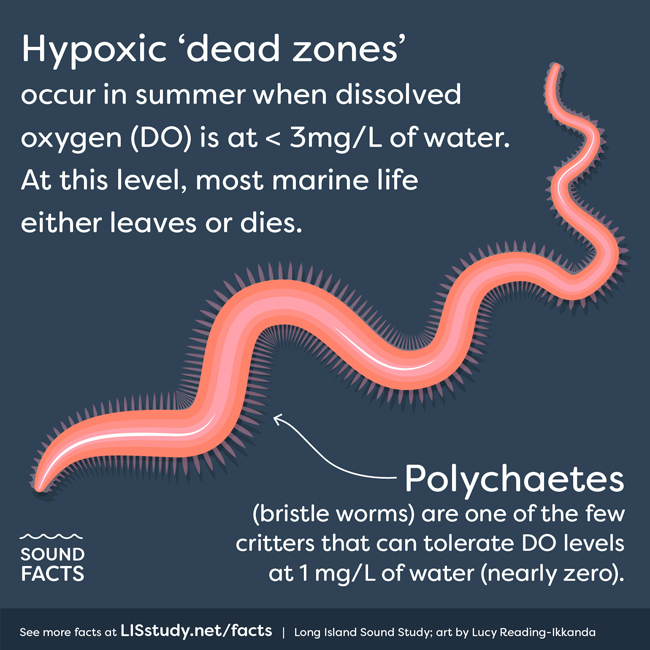
Which species digs into the mudflats and sands along #LongIslandSound's shoreline?
#LISoundFacts: Polychaetes. These squiggly critters, related to earthworms, tolerate very low levels of dissolved oxygen.
Less is known about their forecasting prowess! Learn more about these animals, also known as "bristle worms," in "Low Oxygen, No Problem for Polychaetes", the latest topic in the #LISoundFacts series: bit.ly/lisoundfactspolychaetes.
View this post on ...
Instagram
If the embed for the Instagram post above doesn't show, click here to see the post on Instagram.
Twitter
Facebook
Week 5: Diamondback Terrapins | back to top
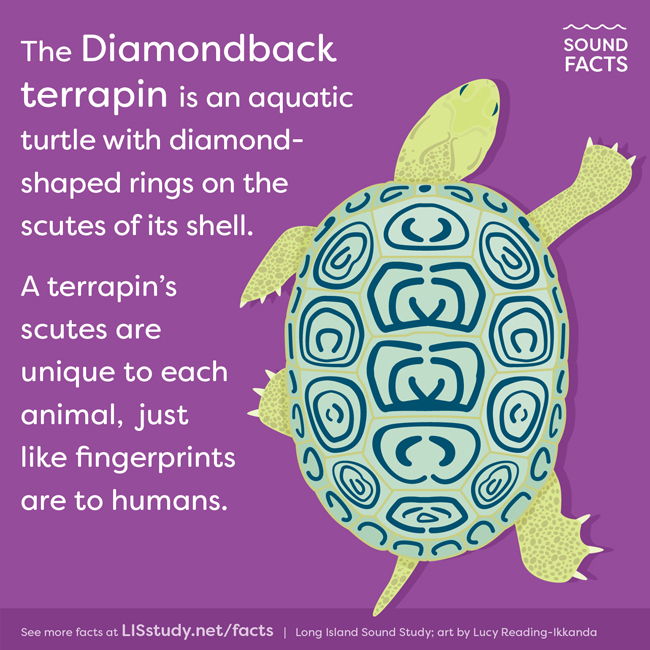
#LISoundFacts: Did you know diamondback terrapins are the only turtles in the world that live exclusively in brackish waters?
Check out "Diamondback Terrapins", the latest topic in the Sound Facts series, to learn more about this unique animal: bit.ly/lisoundfactsdiamondbackterrapins.
View this post on ...
Instagram
If the embed for the Instagram post above doesn't show, click here to see the post on Instagram.
Twitter
Facebook
Week 6: Climate Change and the Sound | back to top
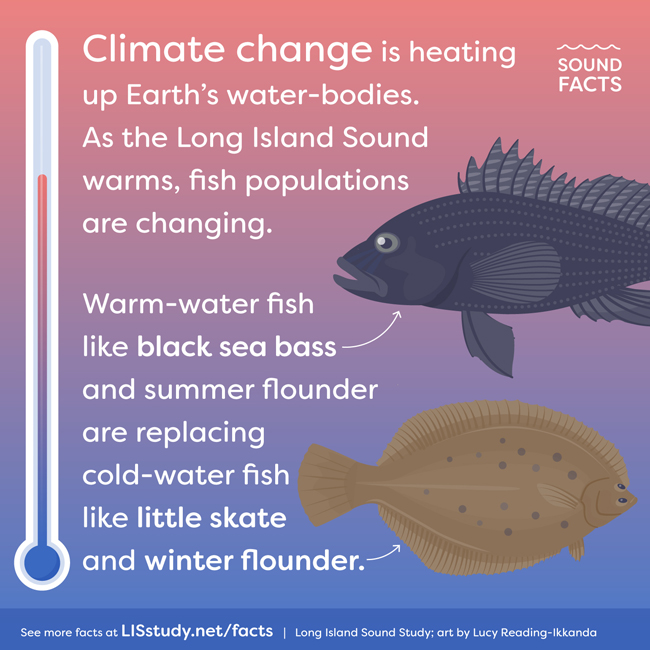
What does changing climate mean for aquatic ecosystems like Long Island Sound?
#LISoundFacts: The Connecticut Department of Energy and Environmental Protection (CTDEEP) conducts the Long Island Sound Trawl Survey every spring and fall to measure fish abundance and biodiversity.
CTDEEP groups species counted in the trawl survey based on their temperature tolerance and their seasonal spawning habits as an indicator of climate change. What has been observed is that the number of fish species with greater tolerance to warmer temperatures is increasing, while the number of fish species that prefer colder temperatures is declining.
To read more about changing fish populations and explore some of the data used by local resource managers as indicators of a changing climate, check out "Some Like It Warm", the latest topic in the Sound Facts series: bit.ly/lisoundfactsclimatechange.
View this post on ...
Instagram
If the embed for the Instagram post above doesn't show, click here to see the post on Instagram.
Twitter
Facebook
Week 7: Sugar Kelp | back to top
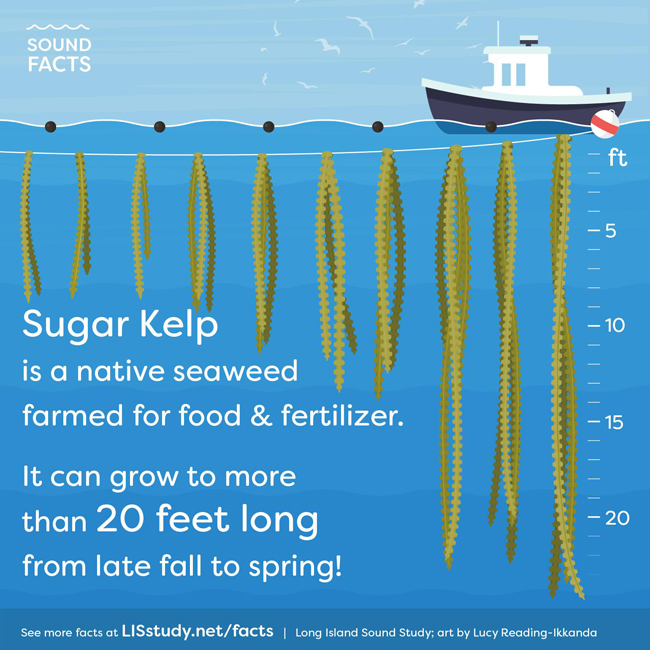
What can grow to be more than 20 feet long, be used to help mitigate nutrient pollution in the Sound, and sort of look like lasagna noodles?
#LISoundFacts: SUGAR KELP!
Read "Sugar Kelp", the latest topic in the #LISoundFacts series, to learn more about this seaweed's many uses and how it is being used in LIS to improve water quality: https://bit.ly/lisoundfactssugarkelp.
View this post on ...
Instagram
If the embed for the Instagram post above doesn't show, click here to see the post on Instagram.
Twitter
Facebook
Week 8: Beach Cleanups | back to top
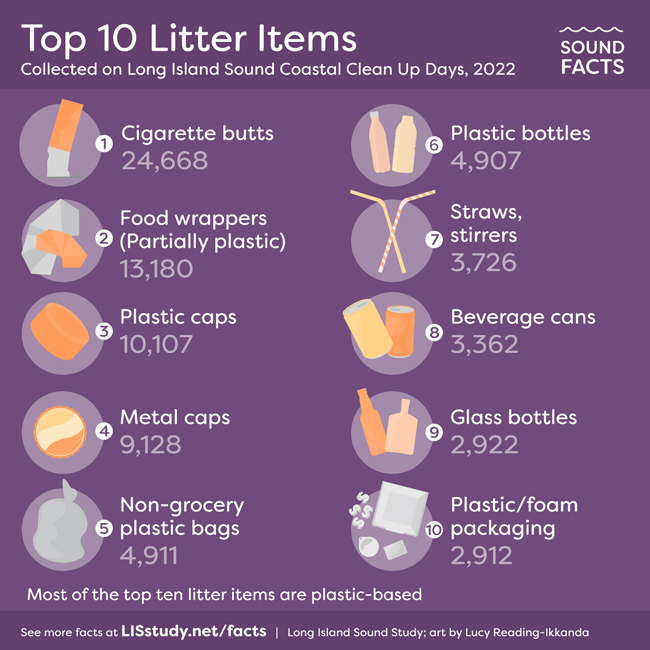
What's the #1 trash item collected at Long Island Sound beach cleanups?
Cigarette butts! As part of the annual #DontTrashLISound summer campaign, the Long Island Sound Study (LISS) creates a list of the top 10 litter items collected each fall in both New York and Connecticut by volunteers at Long Island Sound beaches. Since 2015, cigarette butts have been the top category on the list of trash collected.
Learn more: https://bit.ly/lisoundfacts2022beachcleanups.
View this post on ...
Instagram
If the embed for the Instagram post above doesn't show, click here to see the post on Instagram.
Twitter
Facebook
Week 8: Alewives | back to top
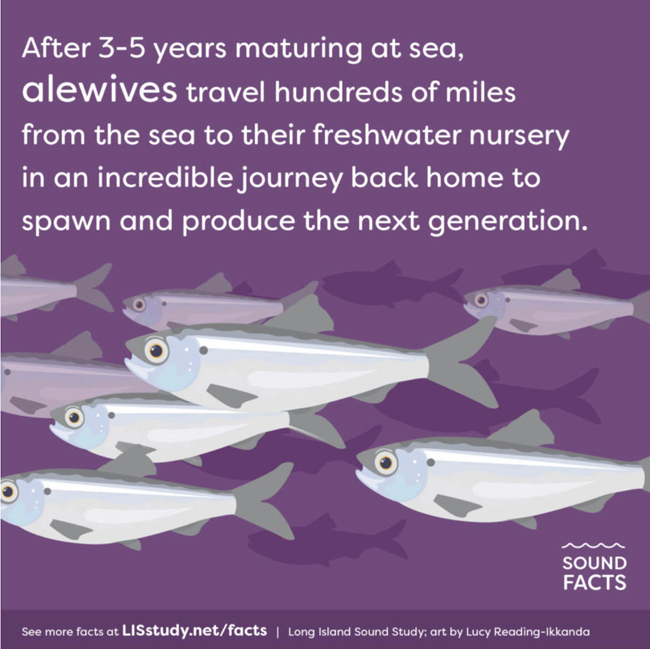
Silvery alewives (river herrings) spend most of their lives at sea and journey back to freshwater to spawn at the same river where they hatched.
Historically, these fish were so abundant that they would "turn the river silver" every spring when they migrated upstream to spawn.
#LISoundFacts: Alewives hold an important role in the ecosystem, serving as prey for animals such as striped bass, ospreys, and seals.
Unfortunately, alewife numbers have declined due to bycatch, overfishing, pollution, and loss of access to rivers because of dams and culverts. Efforts to help restore alewife numbers include the construction of fishways, alewife monitoring through citizen science, and the introduction of pre-spawn adults to rivers that had historically supported spawning.
Find out more about alewives and these ongoing efforts in "Alewives on the Move", the latest topic in the Sound Facts series: https://bit.ly/lisoundfactsalewives.
View this post on ...
Instagram
If the embed for the Instagram post above doesn't show, click here to see the post on Instagram.
Twitter
Facebook
Week 9: Invasive Species | back to top
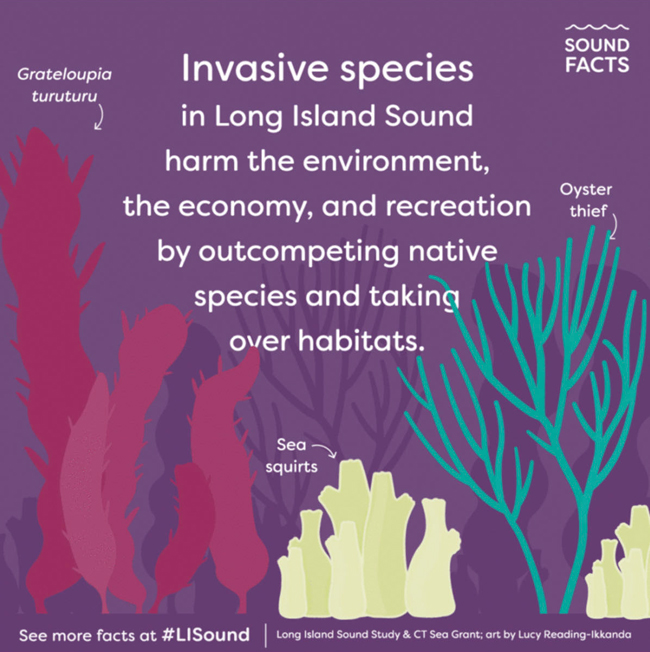
Invasive Species in Long Island Sound harm the environment, the economy, and recreation by outcompeting native species and taking over habitats.
Find out more in "Aquatic Invaders of the Sound", the latest topic in the #LISoundFacts series: https://bit.ly/lisoundfactsaquaticinvaders.
View this post on ...
Instagram
If the embed for the Instagram post above doesn't show, click here to see the post on Instagram.
Twitter
Facebook
Week 10: Wetlands | back to top
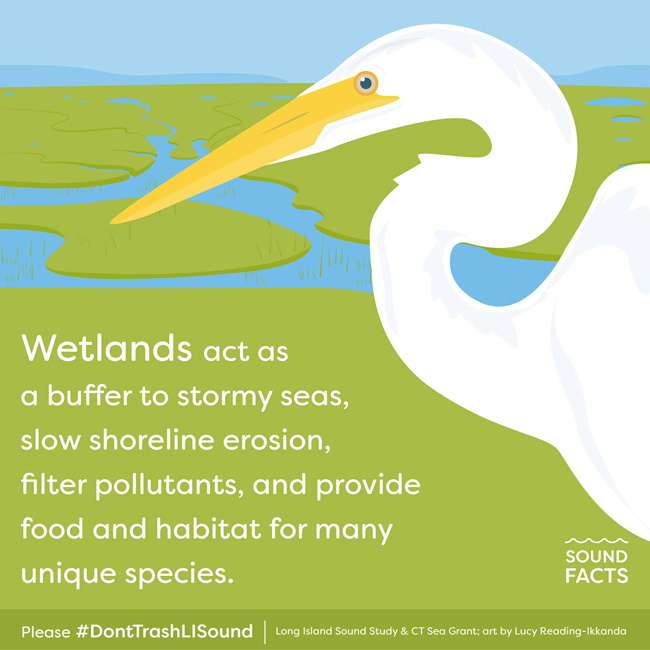
With National Estuaries Week nearly upon us, we ask, “Why are wetlands so vital?”
Each year, this week is a celebration of these incredible ecosystems and the benefits estuaries provide, including recreational opportunities, which are especially important to physical and mental health.
These important areas provide vital habitat for coastal species and protect our shorelines from extreme storms and sea level rise.
#LISoundFacts: Since 1998, the Long Island Sound Study and its federal, state, and local partners have restored more than 1,000 tidal wetland acres around #LongIslandSound to protect our shorelines, and to provide wildlife habitat.
Find out more in "Why Celebrate Wetlands?", the latest topic in the #LISoundFacts series: https://bit.ly/lisoundfactswetlands.
View this post on ...
Instagram
If the embed for the Instagram post above doesn't show, click here to see the post on Instagram.
Twitter
Facebook
Week 11: Ecosystem Health | back to top
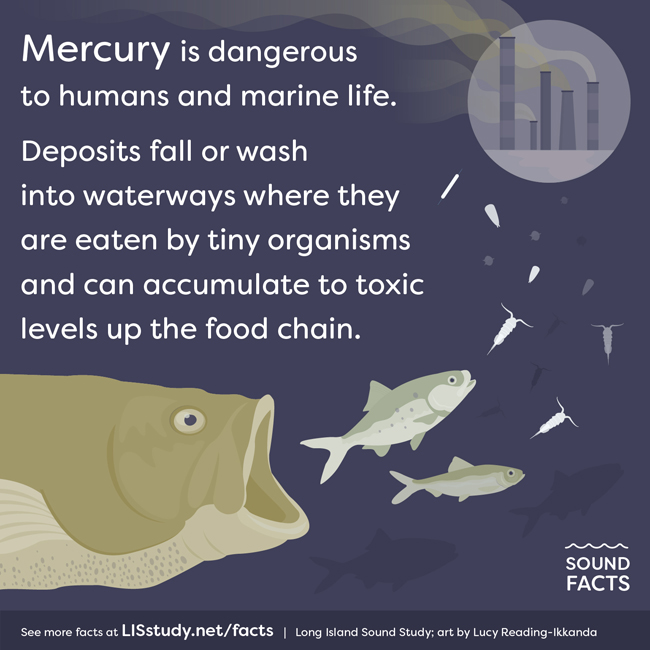
Why do toxic chemicals pose a larger threat to animals that are higher up in the food chain?
Being at the top of the food chain is generally a pretty great perk. However, it does have its downsides … such as biomagnifcation — the process by which chemicals consumed by smaller organisms accumulate in the tissues of the fish who eat them higher up the food chain.
Learn more about this phenomena, the history of mercury in #LongIslandSound waters, and how to stay safe when eating what you fish in "Fish Take Mercury Up the Food Chain", the latest topic in the #SoundFacts series: https://bit.ly/lisoundfactfoodchain.
View this post on ...
Instagram
If the embed for the Instagram post above doesn't show, click here to see the post on Instagram.
Twitter
Facebook
Week 12: Sound Depth | back to top
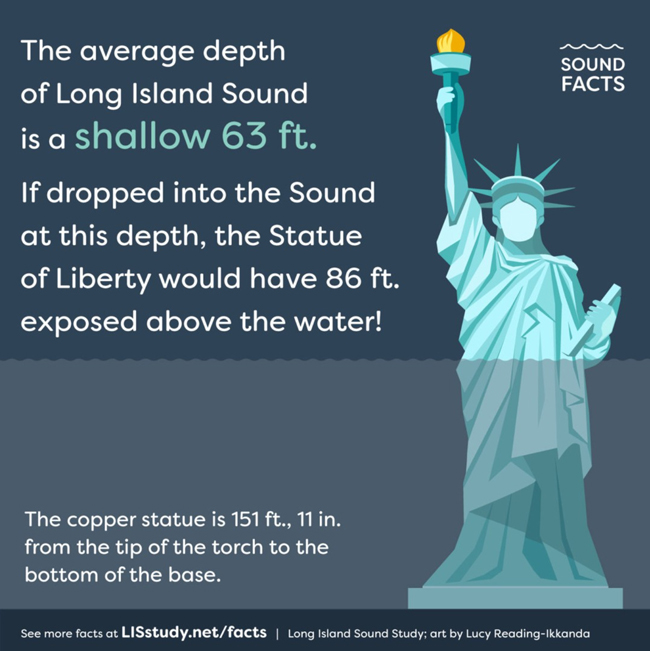
For this #LISoundFacts scene on we ask, “How deep is the #LongIslandSound?”
Turns out it varies greatly by location.
• In the western Sound, the depths can be well under 20 feet
• The central Sound is around 65 feet
• The eastern Sound is deep, dipping to 350 feet at the Race.
But why do we say the Sound is, on average, shallow?
Find out more in "How Deep is the Sound", the latest topic in the Sound Facts series: https://bit.ly/lisoundfactssounddepth.
View this post on ...
Instagram
If the embed for the Instagram post above doesn't show, click here to see the post on Instagram.
Twitter
Facebook